The Hands of Orlac (1924)
Directed by: Robert Wiene
Written by: Louis Nerz, Maurice Renard
Starring: Alexandra Sorina, Conrad Veidt, Fritz Strassny, Paul Askonas
AKA ORLAC’S HANDES
AUSTRIA
AVAILABLE ON BLU-RAY: 14TH JUNE, from EUREKA ENTERTAINMENT
RUNNING TIME: 92 mins
REVIEWED BY: Dr Lenera
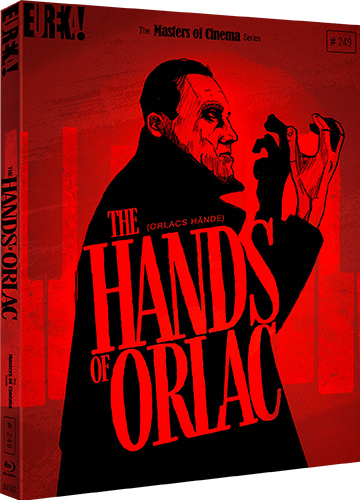
Concert pianist Paul Orlac loses his hands when the train he’s on crashes into another. His wife Yvonne pleads with Dr. Serral to help, so Serral transplants onto Orlac’s arms the hands of a recently executed murderer named Vasseur. When Orlac learns of whom his hands originally belonged to, the horror begins to obsess him while the hands sometimes seem to have a mind of their own. He doesn’t even want to touch Yvonne in case he harms her. Serral tells him that a person’s acts are not governed by hands, but by the head and heart, but Orlac doesn’t believe him, while his inability to work is making the couple fall into poverty….
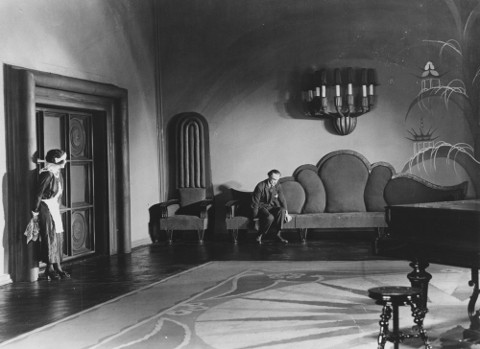
I’ve been extremely keen to see The Hands Of Orlac over the last few months. This was partly because I recently, in a mini series of non-Universal horror films from the 1930’s, watched and reviewed its first remake Mad Love, the last great chiller of its decade, with Peter Lorre in terrific form as Dr. Gogol, a mad scientist obsessively in love with Yvonne, the wife of Paul Orlac, a concert pianist. When Orlac loses his hands in a train accident, Gogol grafts on the hands of a knife murderer. This earlier version is the first major film usage of a premise that was thereafter reused often, with heads, blood and eyes all being transplanted onto people by scientists either not knowing, not caring or actually counting on the possibility that, if said parts came from a criminal, the subject will also begin to have criminal tendencies, a theory that was probably believed by many before some of these transplants actually became achievable in the real world. And then of course we also had all those films where severed hands had a a life of its own. The Hands Of Orlac could even be called the first major body horror movie, but even the first major contemporary horror film, and is therefore a very important one in the genre even if not enough people seem to have seen it. It reunited Veidt with the director of the groundbreaking The Cabinet Of Dr. Caligari, an extraordinary, borderline surreal piece of work that’s lost little of its unique effect. Indeed Veidt delivers another astonishing performance – up to now Bruce Campbell was, for me, the king of possessed hand acting but Veidt bests him and has to do it throughout rather than in just one scene. The film unsurprisingly has plenty of that archetypal German Expressionist feel and look, and only loses its grip and power in its static, ‘loads of people in a room’ ending which undercuts an apparently fantastic element, yet with a “logical” explanation which seems almost as implausible.
The source novel Les Mains d’ Orlac was published in 1920. The writer was Maurice Renard, not a well known author these days but popular at the time at least in France due to his H. G. Wells-like science fiction tales. Initially serialised in a newspaper, its central gimmick only turns up towards the end, and on the audio commentary on this release, we learn that it sidetracks into other things like spiritualism and a gang of knife murderers while focusing greatly on the increasing poverty of the Orlacs. Screenwriter Ludwig Nertz included many details from the book but thankfully foregrounded the main concept. Little seems to be known about the production like many other silent films; even on the commentary the always knowledgeable Stephen Jones and Kim Newman don’t seem to have been able to uncover much. What’s odd is that it was an Austrian production rather than German, shot at the studios of Listo-Film in Vienna, and I can’t seem to find out exactly why when it fits right into the series of horror and fantasy productions made by Germany around the time. It was withdrawn soon after its release in Berlin by the city’s censorship authority, the police claiming that some of the film’s scenes could both inspire potential criminals and impede current police investigations. It was ultimately cleared for general release, though teenagers were still forbidden from seeing it despite no mention of adult-only elements. Though commercially and critically successful in both Austria and Germany, it wasn’t released overseas for three years, the American version losing an entire reel which may have promped the mixed critical reception there. As well as Mad Love, later versions were also made in 1960 with the French/English production The Hands of Orlac, 1964 with the American Hands Of A Stranger, and two German TV movies.
The main difference between this and Mad Love is apparent right from the very beginning. The Karl Freund picture began with Dr. Gogol arriving at a theatre where Yvonne is performing in a play and showing his infatuation with her while Orlac is playing at a concert somewhere else. This one opens with Yvonne in bed reading a love letter from Orlac [the line “I will feel your body tremble under my hands” wouldn’t have made it into a Hollywood film ten years later] before cutting to Orlac, via a very quick shot of a newspaper headline, playing at his concert. Gogol isn’t now just a minor character, he’s not in the film at all. The later film’s inclusion of him and his sexual obssession meant that the ‘possession by hand’ aspect felt rather truncated. Here, it’s most definitely the main focus, meaning that we care much more about Orlac’s plight. The train crash occurs really early, though we don’t see the two vehicles colliding: instead we just cut to people in the office of the nearest station being notified of the disaster. A fair bit of time though is spent on the aftermath, as the camera lingers on the wreckage, the survivors standing outside catching their breath, loads of stretcher bearers running onto the scene, the train’s headlight moving from side to side ominously. Yvonne is there and enters a carriage looking for her husband whom she finds. Cut to Dr. Serral waiting for the execution of a certain Vasseur and arranging for his body to be brought to his laboratory, who has a visitor, Yvonne, who begs him to help. The scene where she collapses onto a chair then walks towards him with outstretched hands while he just stands there rather menacingly is a little odd, but then we are in the world of German silent cinema where every scene tends to be stylised in some way. Serral agrees and we cut to Orlac waiting up, most of his face covered in bandages yet Veidt still being able to evoke the characters’ discomfort.
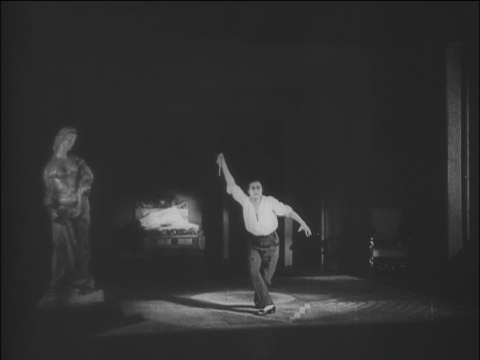
Orlac gets out of bed then collapses in a most pecuiliar manner, but still goes home. Serral eventually tells him the truth about his hands via a note put on his bed while he’s asleep, but obviously believes that nothing could go wrong; Serral clearly is experimenting but equally clearly thinks that he’s doing a very good thing. His intentions are not bad, much like the mad scientists played by Boris Karloff in his ‘mad scientist’ series for Columbia. Orlac sees the face of a man leering at him in a window and has a creepy nightmare where the huge head of the same man, followed by his arm, appear before him. And those hands. They just don’t feel right. First of all he just looks at them and slowly moves his fingers. Then he finds that his wedding ring is too big. Then he goes to play his piano, and what’s especially interesting is that he spends more time putting his fingers on the keys and slowly moving them across them, rather than pressing the keys properly; a strange but notable touch, as if Orlac not only can’t play the piano but doesn’t seem to know how to. Then not only do his fingers start moving as if they have a mind of their own but his whole body seems to be possessed, pulled about by his hands in strange ways, at one point even lunging at the camera and at another trying to pull his hands off! Whether you like the exaggerated acting style of German Expressionist or not [I do because I feel it adds to the weird atmosphere and the heightened style but understand how it can be off putting for some people], Veidt does transmit his character’s agony in intense acting of both a physical and emotional kind. These scenes last a very long time though aren’t boring at all, while the takes are frequently long, which is common for the time but which makes Veidt’s work seem even more impressive. Even his veins become more prominent at some points!
You’d have thought that Viedt’s barnstorming would overshadow any other performance, but Alexandra Sorina as Yvonne has much emotional power to her performance despite it being far more conventional of the times, while Fritz Kortner has a more subtle yet still strong and very sinister presence as – well – I don’t want to really say as it ‘ll give a lot away! The plot is qactually uite slow to develop, but I don’t think that anyone who’s seen a few silent movies will lose interest. We realise more and more that this couple are getting poorer and that something has to be done about it. Will Orlac’s dad help? What is the house maid Regina up to? It doesn’t seem like it’s anything good. There’s a peculiar and rather perversely sexual scene between Orlac and Regina. Orlac doesn’t want to touch his wife, therefore meaning that he can’t be intimate with her, but Regina presents her head to him and he not just puts his hands all over it but clearly gets erotic fulfillment from doing so. A body then turns up. Did Orlac do it because his hands have become totally taken over? It’s interesting to see which things Mad Love used, or rather which things it provided variations on, most notably it’s most iconic scene where Vasseur supposedly appears before Orlac with his previously guillotined head reattached. We know that somebody’s probably impersonating Vasseur, but we’re still chilled. I got the impression that had been totally invented for that film, and was surprised that an early version of that scene appears in this one, and in a way it’s even more effective because we think that what we’re seeing is real and are confused in the best possible way. The last ten minutes really are a let down though and paradoxically ask more questions than they answer, the sheer implausibility of the explanations staying with you, though that’s little different from the many horror-tinged mysteries that were very popular in the USA at the time. And we’re left with a nice final chill and a nice final question right at the end. Was this one of the first horror films to do this too, finish off with a sting in the tail?
The characters tend to be filmed from quite far away so they’re dwarfed by the large rooms they’re in, the fact that the camera hardly seems to move not really a problem. The Orlac house consists of an impossibly huge array of bizarre and huge rooms, dominated by simple but often stark shapes. The twisted surreality of the sets in The Cabinet Of Dr. Caligari is mostly gone, but the imposing nature of the ones here have their own wearing psychological effect. Rooms tend to have only the bare essentials of the script in them, while our attention is sometimes diverted to the patterns on the walls. One bravura shot has the whole screen go out of focus except for a glass of wine that Orlac doesn’t want to drink. Imposing is probably the word, perhaps shown best when Yvonne is tying to get some money. Visiting a money lender, she sits in a chair begging for help [she does a lot of begging] while four men stand behind her holding pieces of paper in a most menacing fashion. Then she goes to her husband’s father, and a servant answers the door and shows her in. The father sits upon a throne while the servant goes and stands behind said throne menacingly. It’s just a heightening of the menace which Yvonne feels, but that’s the kind of thing German Expressionism was all about, and why some of us love the effect these fascinating films have. The Hands Of Orlac may not quite hang together as a whole, but parts of it are magnificent and I feel that it’s been a bit overshadowed by the more popular likes of Nosferatu and The Golem. If you added Lorre and changed the finale we’d have a masterly movie indeed.
.
SPECIAL FEATURES
Limited Edition O-Card slipcase [2000 copies]
1080p presentation on Blu-ray from a restoration of the original film elements by Film Archiv Austria
Obviously sourced from different prints, and only previously released on Blu-ray by Germany’s absolut Median, this is not really one of the best of the HD silent film restorations that we’ve seen, but then we’ve been spoilt in recent years, and we’re told that previous editions of this film looked very poor indeed. Despite many shots and scenes looking more worn than others, everything is still clear, and around three quarters of the footage look fine with only minor damage and plenty of detail. Nothing really to complain about considering the film’s age.
LPCM 2.0 audio
The score by Johannes Kalitzke is very loud and insistent and may at times be too much for some, though I think it suits the film very well. Discordant strings, creepy piano and a female voice imitating various sounds makes for an effectively unsettling sound scape.
Original German language intertitles with optional English subtitles
Brand new feature length audio commentary with author Stephen Jones and author / critic Kim Newman
This track by our favourite commentary duo begins with Jones saying that he likes the film far less than Newman, and he’s quick to point out some issues [he even thinks that Veidt is miscast], though he does say that he likes it a bit more at the end and I certainly believe him. Despite the lack of production info, they still deliver a packed, authoritive and never dull track. They both see Orlac being worried about his hands before he learns of their origin as a flaw, though I must say that I don’t see it that way myself. We have a lot of comparing to the novel and other versions of this story, balanced discussion of pros and cons, and plenty of valid and interesting observations.
Extremities: Brand new video essay by filmmakers David Cairns and Fiona Watson [26 mins]
Cairns and Watson just do writing duties here, leaving the narration to Jessica Martin and, when passages from the novel are being recited, Steven MacNicol. Scored with music very similar to what accompanies the film which adds some appropriate atmosphere, this is a very informative and insightful piece indeed, with some interesting details about Veidt including an Oedipal complex [some of which may have informed his performance], pictures and even clips of a fairy tale and a similar film respectively which preceded Renard’s book, and a look at the whole German Expressionism phase with appropriate clips.
Alternate presentation of The Hands of Orlac [SD]– Courtesy of the F. W. Murnau Foundation, a presentation of the film struck from a different print source, featuring alternate takes of certain scenes [110 mins]
Silent films were often shot in two versions, one for domestic release and one for export, sometimes using the same take from a different angle, sometimes using different takes. I didn’t watch all of this, but it was clear to me that the main difference in running time between this and the other version was because this one had not just some extra shots but that some footage was slightly slowed down, going at a lower frame rate, though this one has shots not in the other one too. There aren’t any actual extra scenes that I could tell, but different takes of some of Veidt’s major scenes show noticeable differences in his performance. The intertitles are in English and the music score by Paul Mercer is more conventionally melodramatic. It doesn’t look as good as the other version, but worth a watch anyway and I’ll definitely view it all at some point soon.
Scene comparisons highlighting some of the differences between the two versions of the film [13 mins]
This is fascinating and tells you what to expect from this cut.
A collector’s booklet featuring new writing by Philip Kemp, and Tim Lucas
A seminal horror film and almost as good a showcase for its magnetic star as The Man Who Laughs. Highly Recommended.





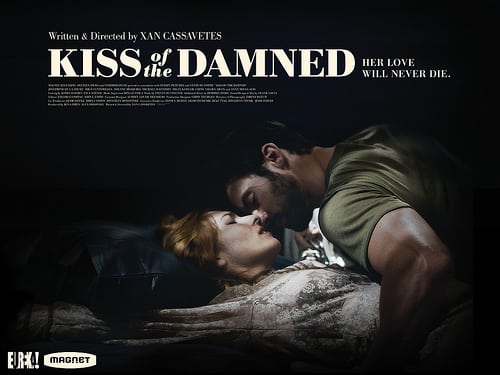
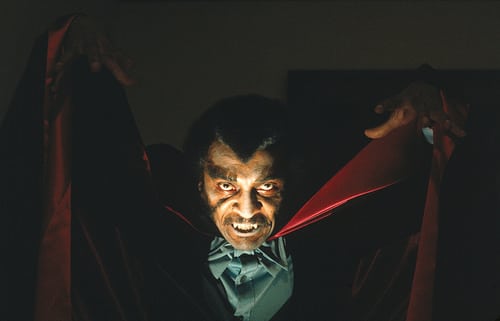
Be the first to comment